Farmer's Welfare
“Harnessing the Blue Economy: India’s Fisheries at a Glance”
Posted On:
23 AUG 2025 9:37AM
Key Takeaways
- Fish production has grown by 104% from 96 lakh tonnes in 2013–14 to 195 lakh tonnes in 2024–25.
- Inland fisheries have expanded by 142% for the same period from 61 lakh tonnes to 147.37 lakh tonnes.
- As of 22 July 2025, Department has approved fisheries development projects worth ₹21,274.16 crore under the Pradhan Mantri Matsya Sampada Yojana.
- As of April 2025, ₹11.84 crore has already been sanctioned under The Pradhan Mantri Matsya Kisan Samridhi Sah-Yojana (PM-MKSSY) to support early implementation.
- As of August 2025, a total of more than 26 lakh stakeholders including fishers, micro-enterprises, Fish Farmer Producer Organisations and private companies have registered on National Fisheries Digital Platform (NFDP).
- As of 29 July 2025, the Department of Fisheries has supported infrastructure projects under the Pradhan Mantri Matsya Sampada Yojana with a total outlay of ₹17,210.46 crore.
- As of June 2025, 4.76 lakh KCCs have been issued to fishers and fish farmers across all States and Union Territories, with a total disbursement of ₹3,214.32 crore.
|
Introduction
Navkishar Gope began with nothing. Displaced from his home, he settled in Gangudih Punarwas village in Jharkhand with no land, no assets and no means of transport. Life was a daily struggle. Joining the Chandil Bandh Visthapit Matsya Jivi Sahakari Samiti changed his path. With guidance from the Fisheries Department, he applied for a cage culture project under Pradhan Mantri Matsya Sampada Yojana (PMMSY) and received financial support to set up a fish culture cage.
At first, his knowledge was limited and profits were small. With training and advice from fisheries officials, he adopted better practices such as regular cage cleaning and proper use of medicines. His production improved, fish mortality reduced and profits soared up.
From not owning even a bicycle, he now has a house and a moped. His success has given him confidence and a dream to expand with more cages. Navkishar’s journey shows how opportunity, guidance and determination can lift a life from hardship to dignity.
India stands as the second largest fish producing nation in the world, contributing around 8% of global output. The sector is a key source of food, jobs and income for millions of families, particularly in coastal and rural areas. Over the last decade it has undergone a major transformation in both scale and method.
From 2013-14 to 2024-25, the country’s total fish production has grown by an impressive 104% comprising both marine and inland sectors. Output has increased from 96 lakh tonnes to 195 lakh tonnes. Much of this growth has come from inland fisheries, which have expanded by 142% in the same period. Production in this segment has risen from 61 lakh tonnes to 147.37 lakh tonnes.
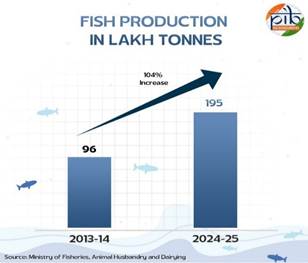
This change reflects a move towards modern, sustainable and high-yield aquaculture. Better technology, improved infrastructure and stronger value chains have helped farmers produce more and earn more. Investments in hatcheries, pond systems, cold chains and market networks have allowed fish to reach consumers faster and in better condition. The result is a stronger sector that feeds more people and supports more livelihoods than ever before.
Budget for Fisheries Sector
The Union Budget 2025-26, proposed the highest ever total annual budgetary support of Rs. 2,703.67 crores for the fisheries sector.
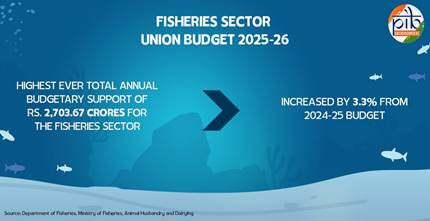
Navigating the Fisheries Transformation Journey
Blue Revolution to PMMSY
The Blue Revolution began in 2015 with the aim of increasing fish production and improving the fisheries value chain across inland and marine sectors. It focused on raising productivity, expanding infrastructure, and bringing modern practices to fishers and fish farmers. Over time, critical gaps remained in areas such as post-harvest handling, traceability, welfare of fishers, and formal linkages to credit and markets. To address these gaps and accelerate the transformation, the Government launched the Pradhan Mantri Matsya Sampada Yojana in 2020. The new programme builds on the gains of the Blue Revolution and extends its reach with greater depth and convergence.
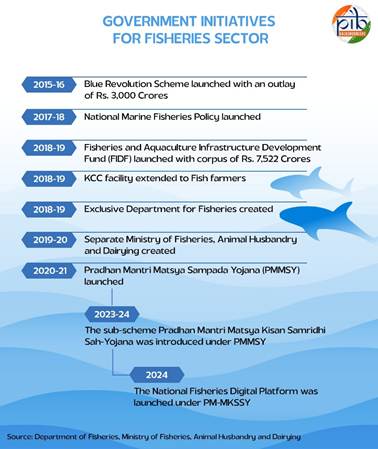
Sectoral Components and Programmes
1.Pradhan Mantri Matsya Sampada Yojana (PMMSY)
The Pradhan Mantri Matsya Sampada Yojana has been created to fill important gaps in India’s fisheries sector. It works to improve fish production and productivity, raise quality standards, bring in modern technology, strengthen post-harvest infrastructure and ensure better management. The scheme also focuses on building a stronger value chain, improving traceability, creating a sound fisheries management system and ensuring the welfare of fishers.
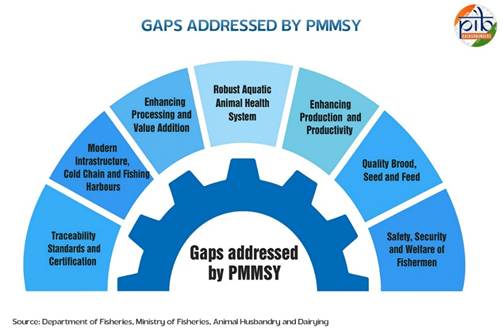
Financial Outlay
Fisheries Development under PMMSY
As of 22 July 2025, The Department of Fisheries has approved fisheries development projects worth ₹21,274.16 crore under the Pradhan Mantri Matsya Sampada Yojana. These approvals are based on proposals received from State Governments, Union Territories and various implementing agencies.
Out of the approved amount, the central share stands at ₹9,189.79 crore. So far, ₹5,587.57 crore has been released to different States, Union Territories and other agencies for the implementation of these projects.
The scheme has contributed significantly to creating both direct and indirect employment in fisheries and allied activities. These include fishing, aquaculture, pond preparation, processing, transportation and marketing. PMMSY continues to play a key role in strengthening livelihoods across the sector.
|
As of 29 July 2025, The Department of Fisheries has accorded approval for formation of existing 2000 fisheries cooperative as FFPOs and formation of new 195 FFPOs.
|
The scheme was approved with a total investment size of ₹20,050 crore. This included ₹9,407 crore from the central government, ₹4,880 crore from state governments and ₹5,763 crore as contribution from beneficiaries for a period of five years from 2020-21 to 2024-25. Ministry of Finance, Department of Expenditure has agreed to the extension of PMMSY up to financial year 2025-26 as per the existing scheme design and funding pattern.
2. Pradhan Mantri Matsya Kisan Samridhi Sah Yojana
The Pradhan Mantri Matsya Kisan Samridhi Sah-Yojana (PM-MKSSY) is a Central Sector Sub-scheme under the Pradhan Mantri Matsya Sampada Yojana (PMMSY). It was approved by the Union Cabinet in February 2024 and is being implemented across all States and Union Territories for a four-year period from 2023-24 to 2026-27 with an estimated financial outlay of ₹6,000 crore. As of April 2025, ₹11.84 crore has already been sanctioned under the scheme to support early implementation.
Purpose and Focus
PM-MKSSY is designed to address the long-standing structural challenges in the fisheries sector. It brings in a mix of financial and technological interventions, backed by institutional reforms. The scheme supports the long-term transformation of the fisheries ecosystem by promoting formalisation, insurance coverage, access to finance, and quality assurance across the value chain.
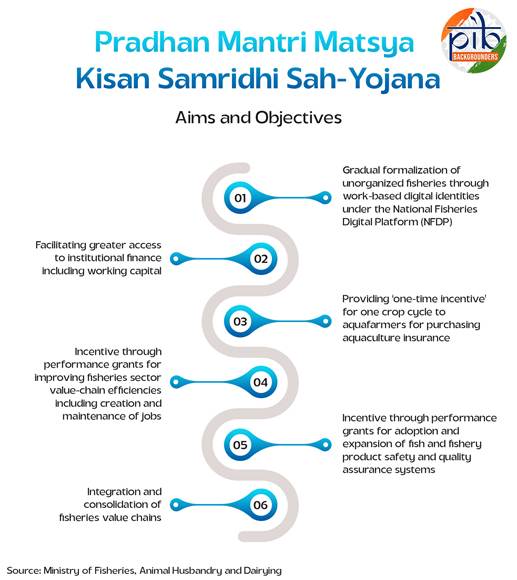
3. National Fisheries Digital Platform (NFDP)
The Department of Fisheries under the Ministry of Fisheries, Animal Husbandry and Dairying launched the National Fisheries Digital Platform (NFDP) on 11 September 2024. This digital platform has been developed under the Pradhan Mantri Matsya Kisan Samridhi Sah-Yojana (PM-MKSSY).
The platform aims to formalise the fisheries and aquaculture sector by creating work-based digital identities for all stakeholders. It is also building a centralised database of fishers, fish farmers, cooperatives, enterprises and other value chain actors.
NFDP acts as a single-window platform that helps beneficiaries access institutional credit, aquaculture insurance, traceability systems and performance-linked incentives. It also supports the strengthening of fisheries cooperatives and provides training and capacity-building opportunities.
The link for NFDP Registration: https://nfdp.dof.gov.in/nfdp/#/?t=PM_MKSSY
As of August 2025, a total of more than 26 lakh stakeholders including fishers, micro-enterprises, Fish Farmer Producer Organisations and private companies have registered on the portal.
|
4.Fisheries and Aquaculture Infrastructure Development Fund
The Fisheries and Aquaculture Infrastructure Development Fund was first announced in the Union Budget of 2018. It was formally launched in 2018–19 by the Department of Fisheries. The fund was created to strengthen infrastructure across marine and inland fisheries. The total fund size is ₹7,522.48 crore.
Extension and Credit Guarantee Facility
To continue this momentum, the Government extended the FIDF scheme for three more years, from April 2023 to March 2026. During this extended period, a credit guarantee facility is being provided using the existing fund from the Animal Husbandry Infrastructure Development Fund (AHIDF).
The scheme offers a credit guarantee cover of up to ₹12.50 crore, helping fishers and entrepreneurs access much-needed credit with lower financial risk. It also provides an interest subvention of up to 3% per year under the FIDF. This support helps Nodal Loaning Entities offer concessional finance at a minimum interest rate of 5% per year.
Implementation and Digital Monitoring
The National Fisheries Development Board (NFDB) serves as the nodal agency for implementing FIDF. It has also developed a dedicated online FIDF portal. This digital platform allows for:
- Online application and tracking
- Separate logins for all stakeholders
- Real-time updates via a live dashboard
The Department of Fisheries, through the National Fisheries Development Board, has prepared an action plan to establish 12,000 fisheries co-operatives in panchayats and villages that have large water bodies or coastal areas but remain uncovered. This plan will be carried out in two phases over ten years. The first phase will cover the formation of 6,000 co-operatives between 2023-24 and 2027-28, while the remaining 6,000 will be formed during the second phase from 2028-29 to 2032-33.
|
Recent Achievements in Fisheries Infrastructure and Investments
As of 29 July 2025, the Department of Fisheries has supported infrastructure projects under the Pradhan Mantri Matsya Sampada Yojana with a total outlay of ₹17,210.46 crore. Out of this, ₹6,761.80 crore has come from the central share.
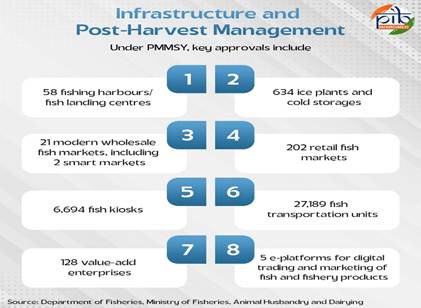
Fisheries Clusters
The Department has officially notified 34 fisheries clusters across the country. This includes dedicated organic fisheries clusters in Sikkim and Meghalaya, encouraging environmentally sustainable practices.
Aquaparks
As of July 2025, Under the Pradhan Mantri Matsya Sampada Yojana, the Department of Fisheries has approved the development of 11 Integrated Aquaparks across various States. The total sanctioned cost for these projects stands at ₹682.60 crore.
|
Integrated Aquaparks serve as comprehensive hubs for fisheries activities. These parks are designed to strengthen every link in the aquaculture value chain. They offer complete infrastructure support starting from fish seed and feed, to farming services, processing, cold storage and access to markets. These parks bring efficiency through cluster-based development. They help reduce post-harvest losses and ensure higher incomes for farmers through value addition and organised marketing.
Support for Startups and Innovation
In a significant step to bring innovation into the sector, the Department is supporting fisheries startups under the PMMSY. Through collaboration with Startup India, startups receive:
- Seed funding
- Incubation support
- Guidance to improve productivity and market access
So far, 39 startup project proposals have been approved with a total subsidy support of ₹31.22 crore under the Entrepreneur Model of PMMSY Scheme.
New Projects Approved in FY 2025–26
As of July 2025, 163 new project proposals from various States, Union Territories and private entrepreneurs have been approved. These projects have a total cost of ₹6,273.31 crore. Of this, ₹4,209.05 crore has been set aside specifically for interest subvention support.
5.Kisan Credit Card for Fisheries
The Kisan Credit Card (KCC) has emerged as a critical tool in ensuring financial inclusion for farmers across India. Designed to provide quick and easy access to working capital, the KCC enables farmers to purchase inputs like seeds, fertilisers and pesticides, and meet cash needs related to crop production and allied activities.
The Government of India has raised the lending limit under the Kisan Credit Card (KCC) scheme for fisheries and allied activities from ₹2 lakh to ₹5 lakh, thereby improving access to credit for fishers, farmers, processors and other stakeholders under the Modified Interest Subvention Scheme.
As of June 2025, 4.76 lakh KCCs have been issued to fishers and fish farmers across all States and Union Territories, with a total disbursement of ₹3,214.32 crore.
|
Since 2019, the scheme has been extended to cover animal husbandry, dairy and fisheries, making it inclusive for allied sectors as well.
6. Dharti Aaba Janjatiya Gram Utkarsh Abhiyan
Dharti Aaba Janjatiya Gram Utkarsh Abhiyan, also known as DA‑JGUA, is the largest tribal development mission in India. It focuses on socio‑economic upliftment of over five crore tribal people across 63,843 villages, 549 districts, and 2,911 blocks. 17 Ministries work together under this scheme for integrated development.
As of July 2025, Under the Dharti Aaba Janjatiya Gram Utkarsh Abhiyan, fish culture support is being extended to 10,000 tribal community groups and 1,00,000 individual beneficiaries.
To facilitate this, a total allocation of ₹375 crore has been made to the Department of Fisheries under the Pradhan Mantri Matsya Sampada Yojana (PMMSY). This includes a central share of ₹225 crore and a state share of ₹150 crore.
|
The scheme aligns fisheries interventions with Pradhan Mantri Matsya Sampada Yojana to ensure asset creation, technical support, and market linkages for tribal communities.
Technologies and Value Chain Enhancements
Under the Pradhan Mantri Matsya Sampada Yojana, focus is being placed on technology-driven practices that promote higher productivity with efficient water use (crop-per-drop).
The PMMSY supports infusion of modern technology across the fisheries value chain, promoting enhanced production, quality, and hygiene. It specifically supports high-density aquaculture technologies such as Recirculatory Aquaculture Systems (RAS) and Biofloc systems.
Recirculatory Aquaculture System
Recirculatory Aquaculture System, or RAS, is a modern fish farming method where water is cleaned and reused through filtration. The system removes waste and impurities, allowing the same water to be used again. It is ideal for farming fish in high numbers using very little land and water. RAS helps conserve resources while maintaining healthy conditions for fish growth.
Biofloc System
Biofloc Technology is a sustainable aquaculture method that recycles nutrients in water using beneficial microbes. These microbes form clumps called biofloc, which serve as natural feed and also help clean the water.
This method requires little or no water exchange, making it ideal for high-density fish farming with minimal resources. It boosts productivity while being environmentally friendly, earning it the name “green soup” or heterotrophic ponds in aquaculture circles.
Approved Projects (2020–21 to 2024–25):
12,000 RAS units approved
- Total Cost: ₹902.97 crore
- Central Share: ₹298.78 crore
4,205 Biofloc units approved
- Total Cost: ₹523.30 crore
- Central Share: ₹180.04 crore
(As of March 2025)
|
Sustainable Modernisation of Fisheries Infrastructure
Smart and Eco-Friendly Fishing Harbours Under PMMSY
The Government of India is actively modernising fisheries infrastructure under the Pradhan Mantri Matsya Sampada Yojana (PMMSY). A major focus is on developing fishing harbours with smart features, green components, and climate resilience. These initiatives are in line with global models like the Eco-Fishing Ports and Blue Port Initiative of the Food and Agriculture Organization (FAO).
Smart and Integrated Fishing Harbours
Three Smart and Integrated Fishing Harbours have been approved under PMMSY:
- Vanakbara in Diu
- Karaikal in Puducherry
- Jakhau in Gujarat
These projects are estimated at ₹369.8 crore and are implemented on a 60:40 cost-sharing basis between the Centre and States. (As of July 2025)
Key Features
- Smart technologies: online auctioning, AI tools, IoT systems, and port management software
- Connectivity: high-speed internet, satellite systems, and cybersecurity measures
- Safety and security: advanced safety gear and surveillance systems
- Renewable energy: solar power units and energy-efficient lighting
- Sustainability: rainwater harvesting and waste processing systems
- Infrastructure: automated ice conveyors, fish handling units, and modern cranes
- Eco-friendly additions: greenery and landscaping around the port areas
Support to Micro and Small Enterprises
The Pradhan Mantri Matsya Kisan Samridhi Sah-Yojana (PM-MKSSY) supports micro and small enterprises for formalization of the fisheries sector with a total investment of ₹6,000 crore. The scheme is backed by external funding of ₹1,500 crore, including ₹1,125 crore from the World Bank and ₹375 crore from AFD.
International Collaboration
- In March 2025, the Department of Fisheries signed a Technical Cooperation Programme with the FAO to strengthen Blue Ports in India.
- In May 2025, a joint workshop was held with the French Development Bank (AFD) to promote the concept of Eco-Fishing Ports
Women and Marginalised Groups in Fisheries
- PMMSY places emphasis on inclusive development.
- Higher financial support is provided to Scheduled Castes, Scheduled Tribes, and women beneficiaries.
- Projects worth ₹3,973.14 crore related to women in fisheries were approved between 2020–21 and 2024–25. (As of March 2025)
Conclusion
India’s fisheries sector is undergoing a major transformation through strong policy support, modern technologies, and inclusive initiatives. Schemes like PMMSY and PM-MKSSY are boosting production, improving infrastructure, and empowering fishers, especially women and tribal communities. With innovations like RAS, Biofloc, smart harbours, and digital platforms, the sector is becoming more sustainable and efficient. These efforts are not only enhancing livelihoods but also contributing to food security and the national economy. The way forward is to build on this momentum for long-term, inclusive growth.
References
Ministry of Fisheries, Animal Husbandry and Dairying
Department of Fisheries
https://dof.gov.in/sites/default/files/2025-04/AnnualReport2025English.pdf
https://dof.gov.in/sites/default/files/2021-10/Reform_Booklet_English.pdf
https://dof.gov.in/fidf
PM India.gov
PM’s address in the 124th Episode of ‘Mann Ki Baat’ | Prime Minister of India
National Fisheries Development Board
https://nfdb.gov.in/PDF/100%20SSS%20English.pdf
https://nfdb.gov.in/PDF/PMMSY-Guidelines24-June2020.pdf
https://nfdb.gov.in/PDF/06_Ras%20Booklet%20Eng.pdf
https://www.nfdb.gov.in/PDF/Biofloc%20booklet%20v6.pdf
Lok Sabha Question
https://sansad.in/getFile/loksabhaquestions/annex/185/AU1422_vx99Ty.pdf?source=pqals
https://sansad.in/getFile/loksabhaquestions/annex/185/AU1413_DS01Ap.pdf?source=pqals
https://sansad.in/getFile/loksabhaquestions/annex/184/AU4924_euUXep.pdf?source=pqals
https://sansad.in/getFile/loksabhaquestions/annex/185/AU429_1EhxCL.pdf?source=pqals
PIB Press Releases
https://www.pib.gov.in/PressNoteDetails.aspx?NoteId=152138&ModuleId=3®=3&lang=1
https://www.pib.gov.in/PressReleasePage.aspx?PRID=2061196
https://www.pib.gov.in/PressReleasePage.aspx?PRID=2130598
https://www.pib.gov.in/PressNoteDetails.aspx?NoteId=154915&ModuleId=3
https://www.pib.gov.in/PressReleseDetailm.aspx?PRID=2117744
https://www.pib.gov.in/PressReleasePage.aspx?PRID=2112266
https://www.pib.gov.in/FactsheetDetails.aspx?Id=149135
https://www.pib.gov.in/PressReleasePage.aspx?PRID=2149640
https://www.pib.gov.in/PressReleasePage.aspx?PRID=2106230
https://www.pib.gov.in/PressReleasePage.aspx?PRID=2110275
https://www.pib.gov.in/PressReleasePage.aspx?PRID=2117260
https://www.pib.gov.in/PressReleasePage.aspx?PRID=2155190
https://www.pib.gov.in/PressReleasePage.aspx?PRID=2149639
Click here for pdf file
*****
SK/SM
(Backgrounder ID: 155080)
Visitor Counter : 5011
Provide suggestions / comments